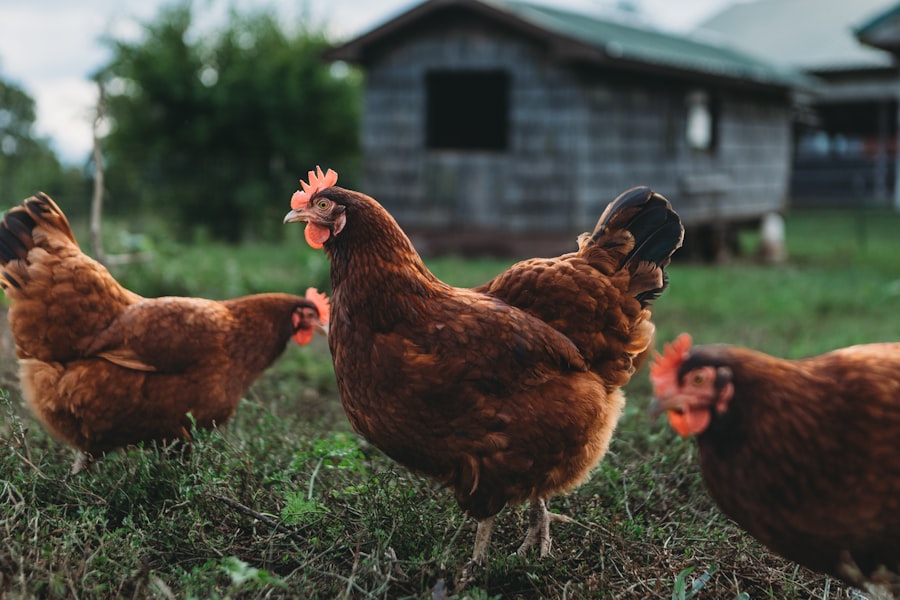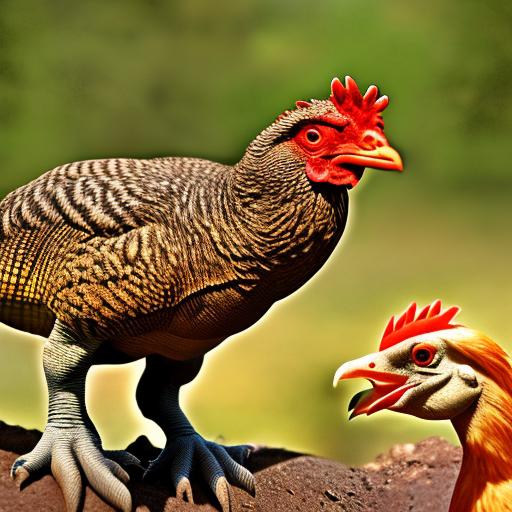Keeping dinosaurs and chickens together may seem like an unusual concept, but it is a growing trend in the world of animal husbandry. As more people become interested in unique and unconventional pets, the idea of cohabiting dinosaurs and chickens has gained popularity. This article will explore the historical context of dinosaurs and chickens coexisting, the differences in their behavior and needs, the potential risks and challenges of keeping them together, the benefits of cohabitation, recommended species for cohabitation, housing and environmental requirements, feeding and nutrition considerations, health and safety precautions, and conclude with recommendations for those interested in this unique form of animal husbandry.
Key Takeaways
- Keeping dinosaurs and chickens together is a unique and unconventional idea.
- Dinosaurs and chickens have coexisted in the past, but under different circumstances.
- Dinosaurs and chickens have different behaviors and needs that must be considered before cohabiting them.
- There are potential risks and challenges to keeping dinosaurs and chickens together, such as safety concerns and dietary differences.
- Benefits of keeping dinosaurs and chickens together include potential educational and entertainment value.
Historical Context
While dinosaurs and chickens may seem like vastly different creatures, there is evidence to suggest that they coexisted in the past. Fossil records have shown that birds are descendants of theropod dinosaurs, which were a group of carnivorous dinosaurs that walked on two legs. This means that chickens are actually distant relatives of dinosaurs.
Despite this connection, there are obvious differences between dinosaurs and chickens. Dinosaurs were much larger and more diverse in terms of species, while chickens are small domesticated birds. Dinosaurs were also reptiles, while chickens are warm-blooded animals. However, these differences should not discourage the idea of keeping them together.
Differences in Behavior and Needs
One of the most important factors to consider when thinking about keeping dinosaurs and chickens together is their behavior and needs. Dinosaurs were wild animals that lived in a variety of habitats and had specific dietary requirements. They were also known to be territorial and aggressive towards other animals. On the other hand, chickens are domesticated birds that have been bred for specific traits such as egg-laying or meat production. They have different social structures and behaviors compared to wild dinosaurs.
Understanding these differences is crucial before attempting to keep dinosaurs and chickens together. It is important to provide an environment that meets the needs of both species and allows them to exhibit their natural behaviors. Failure to do so can result in stress, aggression, and even death.
Potential Risks and Challenges
Keeping dinosaurs and chickens together comes with its fair share of potential risks and challenges. One of the main concerns is aggression. Dinosaurs, especially larger species, can be territorial and may pose a threat to chickens. It is important to carefully select dinosaur species that are known to be more docile and less likely to harm chickens.
Another concern is disease transmission. Dinosaurs and chickens have different immune systems and can be susceptible to different diseases. It is important to implement proper biosecurity measures to prevent the spread of diseases between the two species. This includes regular health checks, quarantine procedures, and vaccination protocols.
Dietary differences are also a challenge when keeping dinosaurs and chickens together. Dinosaurs have specific dietary requirements that may not be met by a typical chicken diet. It is important to provide a balanced diet for both species to ensure they receive the necessary nutrients.
Benefits of Cohabitation
Despite the potential risks and challenges, there are several benefits to keeping dinosaurs and chickens together. One of the main benefits is pest control. Dinosaurs, especially smaller species, can help control pests such as rodents and insects that may be a nuisance to chickens. This can reduce the need for chemical pest control methods and create a more natural and sustainable environment.
Another benefit is fertilization. Dinosaurs produce large amounts of waste, which can be used as fertilizer for plants. This can help improve soil quality and promote plant growth in the area where the dinosaurs and chickens are kept together.
Lastly, cohabiting dinosaurs and chickens can provide entertainment value. Watching these two species interact with each other can be fascinating and educational for both children and adults alike.
Recommended Species

When considering cohabitation between dinosaurs and chickens, it is important to select the right species that are suitable for living together. Some recommended species of dinosaurs include small herbivorous dinosaurs such as the Compsognathus or the Hypsilophodon. These smaller dinosaurs are less likely to pose a threat to chickens and can coexist peacefully.
For chickens, it is recommended to choose breeds that are known for their docile nature and ability to adapt to different environments. Some suitable breeds include the Rhode Island Red, the Sussex, and the Orpington.
Housing and Environmental Requirements
Creating a suitable housing and environmental setup is crucial for the well-being of both dinosaurs and chickens. The size of the enclosure should be large enough to accommodate both species comfortably. It should also provide separate areas for each species to retreat to if needed.
Temperature and lighting are important considerations as well. Dinosaurs may require specific temperature ranges depending on their species, while chickens have their own temperature requirements. It is important to provide a temperature gradient within the enclosure to allow both species to regulate their body temperature.
Feeding and Nutrition Considerations
Feeding and nutrition considerations are essential when keeping dinosaurs and chickens together. Dinosaurs have specific dietary requirements that may not be met by a typical chicken diet. It is important to provide a varied diet that includes a mix of plant matter, insects, and other protein sources for dinosaurs.
For chickens, it is important to provide a balanced diet that meets their nutritional needs. This includes a mix of grains, vegetables, fruits, and protein sources such as insects or mealworms.
Health and Safety Precautions
Keeping dinosaurs and chickens together requires careful attention to health and safety precautions. Regular health checks should be conducted for both species to ensure they are in good health. Quarantine procedures should also be implemented for new additions to the enclosure to prevent the spread of diseases.
Parasite control is another important aspect of maintaining the health of both species. Regular deworming and flea/tick prevention measures should be implemented to keep parasites at bay.
Predator protection is crucial for the safety of chickens. Dinosaurs, especially larger species, may pose a threat to chickens. It is important to provide secure fencing and housing to prevent any potential attacks.
Conclusion and Recommendations
In conclusion, keeping dinosaurs and chickens together is a unique form of animal husbandry that requires careful consideration and planning. While there are potential risks and challenges, there are also several benefits to cohabitation. It is important to do thorough research, consult with experts, and ensure that the needs of both species are met before attempting to keep them together. By providing a suitable environment, balanced diet, and implementing proper health and safety precautions, it is possible to create a harmonious living arrangement between dinosaurs and chickens.
If you’re interested in the fascinating world of keeping dinosaurs and chickens together, you might also want to check out this informative article on Poultry Wizard’s website. It explores the different types of chicken coops that can be used for housing both dinosaurs and chickens. From the practical and spacious Chicken Coop Grand Island, NE, to the compact and portable A-Frame Chicken Coop, and even the unique Chicken Coop Trampoline, this article provides valuable insights into creating a safe and comfortable environment for these diverse creatures. So, if you’re ready to embark on this extraordinary adventure, click here to read more: https://poultrywizard.com/keeping-chickens/chicken-coop-grand-island-ne/.
FAQs
What is the article about?
The article is about whether it is possible to keep dinosaurs and chickens together.
Can dinosaurs be kept as pets?
No, dinosaurs are extinct and cannot be kept as pets.
What are the closest living relatives of dinosaurs?
Birds are the closest living relatives of dinosaurs.
Can chickens and birds be kept together?
Yes, chickens and birds can be kept together as they are both birds.
What are the risks of keeping chickens and birds together?
There is a risk of disease transmission between different bird species, so it is important to keep them healthy and separate if necessary.
Can chickens and other animals be kept together?
It depends on the animal. Chickens can be kept with other poultry, such as ducks and geese, but may not be compatible with other animals such as dogs or cats.
What should be considered before keeping chickens and birds together?
It is important to consider the space available, the compatibility of the birds, and the potential risks of disease transmission. It is also important to provide appropriate food, water, and shelter for all birds.
Meet Walter, the feathered-friend fanatic of Florida! Nestled in the sunshine state, Walter struts through life with his feathered companions, clucking his way to happiness. With a coop that’s fancier than a five-star hotel, he’s the Don Juan of the chicken world. When he’s not teaching his hens to do the cha-cha, you’ll find him in a heated debate with his prized rooster, Sir Clucks-a-Lot. Walter’s poultry passion is no yolk; he’s the sunny-side-up guy you never knew you needed in your flock of friends!







